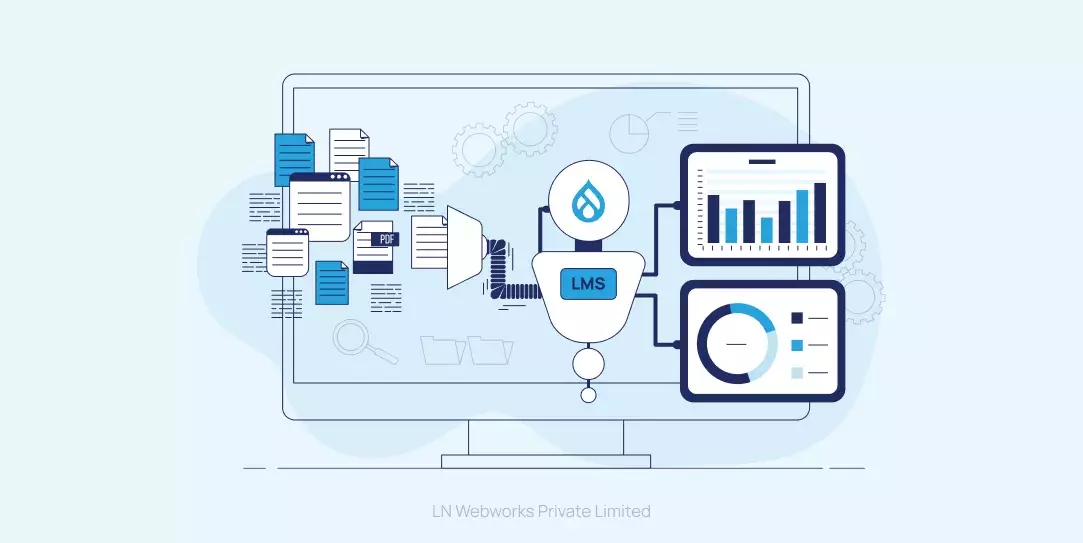Subscribe To Our NewsLetter
Share This Post:
Today, Drupal has become an integral part of the world of e-learning. The largest ed-tech companies in the world have their learning management systems (LMSs) built on this ingenious platform. Drupal development provides phenomenal features such as multilingual compatibility, student segmentation and reporting, cutting-edge security, certification, and impeccable loading speed have contributed to its unmatchable success. Besides, the consistently spectacular performance of Drupal-based LMSs has brought the technology into the limelight.
If this agile platform has also captivated your heart, it’s time to unveil how you can build your learning management system on Drupal. As Drupal is infused with user-friendliness, the process is far from taxing. The built-in modules and themes make everything effortless. However, as the platform is based on PHP, it requires some coding experience for a customized setup. So, you might need to hire a skilled Drupal web development team to create a splendid LMS for you.
5 Steps to Create Your Drupal LMS Effortlessly
Customization is unquestionably what matters the most to the users when it comes to interacting with an LMS. If their core needs are compromised during their interaction with your LMS, the game is over. Being a cutting-edge content management system (CMS), Drupal understands that customization is the immediate concern for all ed-tech companies.
Hence, it has evolved into a fabulously customizable and easy-to-use CMS that can be used to develop an agile LMS. It has the potential to take the e-learning experiences of students and teachers to a whole new dimension. You’ll experience the truth of these words while developing your Drupal LMS. Now, before you begin daydreaming about your incredible Drupal-based LMS and lose track of things, without further ado, let’s dive into the process of making the actual creation happen.
1. Designating User Profiles and Roles
In your LMS, different user types, such as students and teachers, require distinct access to resources. Teachers need access to notes, student progress, and related information, while students require features like class recordings and curriculum materials. To ensure a smooth experience, install and enable the Profile module. This allows you to set user groups, including anonymous, authorized, confirmed users, and more. Designating these profiles ensures visitors can access appropriate resources effortlessly. You can customize access settings for each profile, ensuring flawless functionality of your LMS.
Notably, profile fields are visible only to the profile owner and administration, establishing a secure digital experience. With Drupal, you have the freedom to modify user profiles as needed. Isn't it incredible? Have you already envisioned the user profiles that will enrich your Drupal LMS?
2. Organizing Engaging Virtual Classrooms
In the past, remote learning struggled to replicate the immersive experience of traditional classrooms. However, platforms like Drupal have revolutionized remote learning, bridging the gap between virtual and in-person education. With Drupal-based LMSs, both teachers and learners can enjoy the authentic classroom experience in an online setting.
To provide exceptional experiences, install Drupal's Organic Groups module. It allows users to create organic groups, enabling learners to form study groups with friends and simulate the camaraderie of traditional classrooms. They can easily share study material and engage with each other on the homepage, fostering a sense of togetherness. These features enhance digital experiences, promoting customer satisfaction and loyalty.
For teachers, Drupal's Group tool empowers them to create dedicated virtual classrooms for specific student groups. They have complete freedom to create academic content for seamless student access. Additionally, Drupal LMS addresses doubt resolution by offering forums where learners can seek clarifications from educators. This interactive feature ensures timely support and enhances the learning experience.
With Drupal, virtual classrooms become engaging hubs of collaborative learning, bringing the benefits of traditional education to the online realm.
3. Adding content with the IMCE module
When developing an LMS, it is essential to bear in mind that teachers lead the learning sessions. They are the ones who actually interact with the learners and understand their needs to the core. Given that, it is crucial they be able to exercise the freedom to upload the desired images, modify them, edit and create new folders, add new content, and so on. This way, they can tailor the learning experiences in alignment with the requirements of their students.
Besides, IMCE’s file sorting tool and multiple file selection options also make it easier for them to navigate through the platform. Your LMSs overall digital experience is not only determined by the learners but also the teachers. If they find the LMS tough to ace, it can make them feel distressed and contribute to negative reviews and word-of-the-mouth marketing. This is highly undesirable. So, it is imperative to add the content to your LMS with the IMCE module.
4. Organizing Content with Drupal Taxonomy
A neat and organized e-learning platform is highly appealing, while chaos breeds frustration and drives users away. The key to maintaining a tidy and attractive edtech website lies in sorting all types of content into well-classified groups. Just as you instinctively search for your old photographs in a dedicated picture folder on your laptop, classifying all content available on your LMS into well-defined groups is crucial for delivering a top-notch user experience.
Drupal's Taxonomy module is purpose-built for this task, allowing you to seamlessly connect, relate, and classify educational content. With the module, you can gather classified terms within vocabularies, which are dedicated groups of data easily managed. When users search for specific terms on your LMS, the taxonomy module displays related search results, including relevant subgroups. This ensures a seamless experience in finding courses, pages, and specific content types, resulting in an enhanced user experience and increased engagement.
5. Embedding Videos with the Video Embed Field Module
Video content has been proven to enhance student motivation, improve comprehension, and aid memory retention. Unlike reading extensive text, which often leads to sluggishness, video content keeps learners engaged and attentive. We can all relate to the experience of feeling drowsy while reading school textbooks. Even in virtual learning, where vast amounts of content still need to be absorbed, relying solely on text can have the same effect. The solution? Incorporate video content into your learning modules effortlessly using Drupal's Video Embed Field module.
Simply install and activate the module to easily embed captivating educational videos from platforms like YouTube and Vimeo. Add the video's URL, and learners will be able to preview the thumbnails, providing an engaging and interactive learning experience.
Let’s Wrap Up
Numerous organizations are leveraging Drupal’s unfathomable potential as an LMS to train their employees. Multiple educational organizations have built their learning management system on Drupal to offer engaging remote learning experiences to their students. Given the phenomenal features of a Drupal LMS such as seamless video integration and multilingual compatibility, it can be a great choice for your ed-tech site too.
To add to the advantages of a Drupal LMS, it is easy to set up. However, it is crucial to remember that if you are from a non-coding background you might require the assistance of a Drupal web development company. This is because a customized Drupal LMS setup requires knowledge of the basics of coding. LN Webworks, a distinguished Drupal web development company can help you create your Drupal LMS in a captivating and profitable manner. So, why wait? Contact us today!
Share This Post:
Author Information

Deepak
Deepak has a close to decade of experience working as a brand and digital designer. His experiences with visual design, web design, print design, and animation have established him as a useful force wherever he is able to serve.
Let us help you with Drupal LMS
Related Articles
May 10, 2023
Top Drupal LMS Features for Your Ed-Tech Business
May 9, 2023
Drupal for LMS: Pros of the Industry Giant
May 8, 2023



